FIN2024 - Blockchain Technology: Reviewing Implementation in Finance
VerifiedAdded on 2023/06/04
|8
|2077
|419
Essay
AI Summary
This essay critically reviews the viability of implementing blockchain technology in the financial industry, considering the uncertainties of the global economy and current geopolitical pressures. It examines the influence of technological and environmental factors on the diffusion of blockchain, including improved security, instant transactions, improved transparency, reduced errors, transaction power consumption, and mining power consumption. The essay also discusses the influence of blockchain technology on the decision-making process, focusing on permission sets, decision-making process optimization, and real-time decisions with customers. It concludes that blockchain technology holds a positive influence on the decision-making process within the financial industry sector.
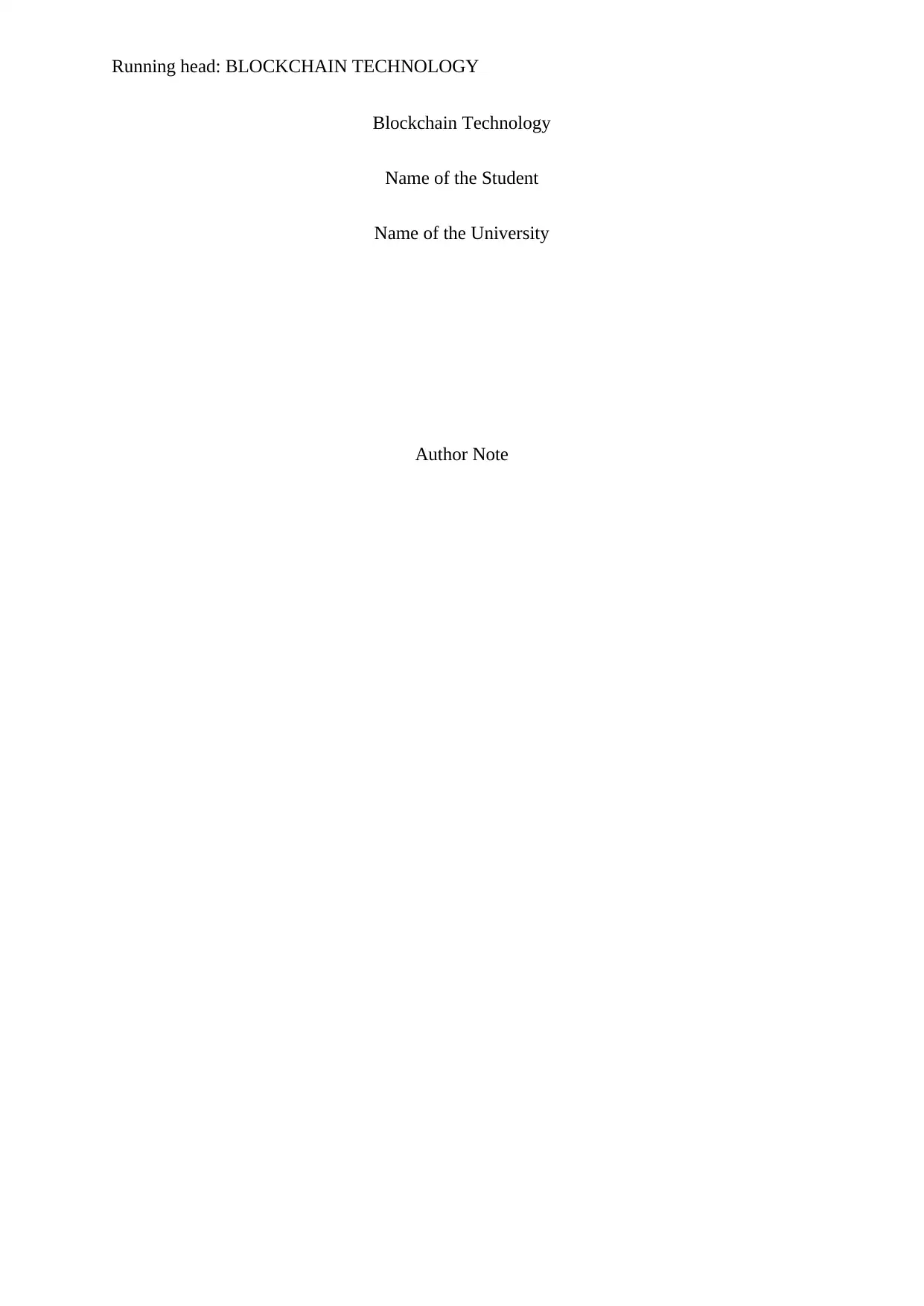
Running head: BLOCKCHAIN TECHNOLOGY
Blockchain Technology
Name of the Student
Name of the University
Author Note
Blockchain Technology
Name of the Student
Name of the University
Author Note
Paraphrase This Document
Need a fresh take? Get an instant paraphrase of this document with our AI Paraphraser
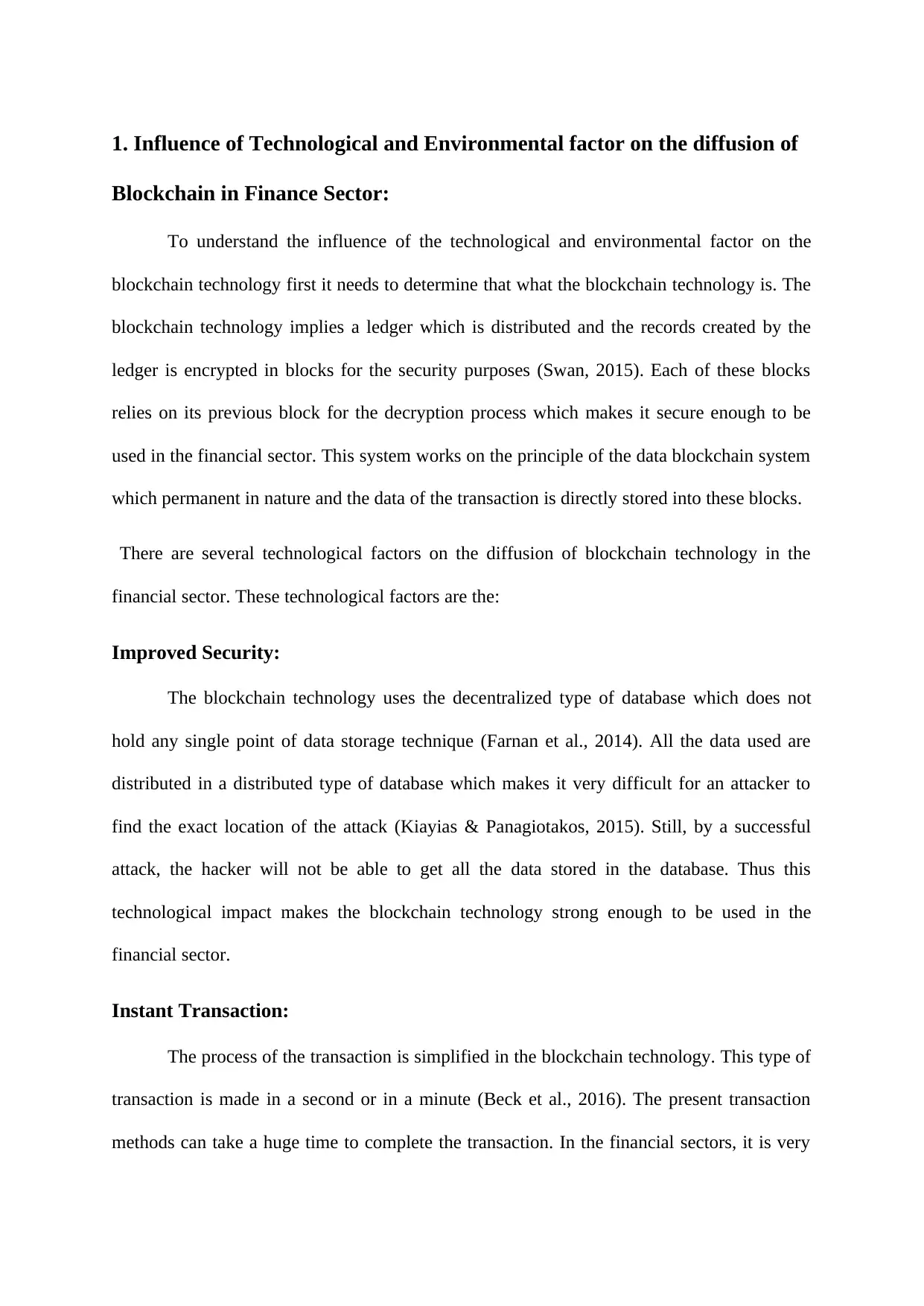
1. Influence of Technological and Environmental factor on the diffusion of
Blockchain in Finance Sector:
To understand the influence of the technological and environmental factor on the
blockchain technology first it needs to determine that what the blockchain technology is. The
blockchain technology implies a ledger which is distributed and the records created by the
ledger is encrypted in blocks for the security purposes (Swan, 2015). Each of these blocks
relies on its previous block for the decryption process which makes it secure enough to be
used in the financial sector. This system works on the principle of the data blockchain system
which permanent in nature and the data of the transaction is directly stored into these blocks.
There are several technological factors on the diffusion of blockchain technology in the
financial sector. These technological factors are the:
Improved Security:
The blockchain technology uses the decentralized type of database which does not
hold any single point of data storage technique (Farnan et al., 2014). All the data used are
distributed in a distributed type of database which makes it very difficult for an attacker to
find the exact location of the attack (Kiayias & Panagiotakos, 2015). Still, by a successful
attack, the hacker will not be able to get all the data stored in the database. Thus this
technological impact makes the blockchain technology strong enough to be used in the
financial sector.
Instant Transaction:
The process of the transaction is simplified in the blockchain technology. This type of
transaction is made in a second or in a minute (Beck et al., 2016). The present transaction
methods can take a huge time to complete the transaction. In the financial sectors, it is very
Blockchain in Finance Sector:
To understand the influence of the technological and environmental factor on the
blockchain technology first it needs to determine that what the blockchain technology is. The
blockchain technology implies a ledger which is distributed and the records created by the
ledger is encrypted in blocks for the security purposes (Swan, 2015). Each of these blocks
relies on its previous block for the decryption process which makes it secure enough to be
used in the financial sector. This system works on the principle of the data blockchain system
which permanent in nature and the data of the transaction is directly stored into these blocks.
There are several technological factors on the diffusion of blockchain technology in the
financial sector. These technological factors are the:
Improved Security:
The blockchain technology uses the decentralized type of database which does not
hold any single point of data storage technique (Farnan et al., 2014). All the data used are
distributed in a distributed type of database which makes it very difficult for an attacker to
find the exact location of the attack (Kiayias & Panagiotakos, 2015). Still, by a successful
attack, the hacker will not be able to get all the data stored in the database. Thus this
technological impact makes the blockchain technology strong enough to be used in the
financial sector.
Instant Transaction:
The process of the transaction is simplified in the blockchain technology. This type of
transaction is made in a second or in a minute (Beck et al., 2016). The present transaction
methods can take a huge time to complete the transaction. In the financial sectors, it is very
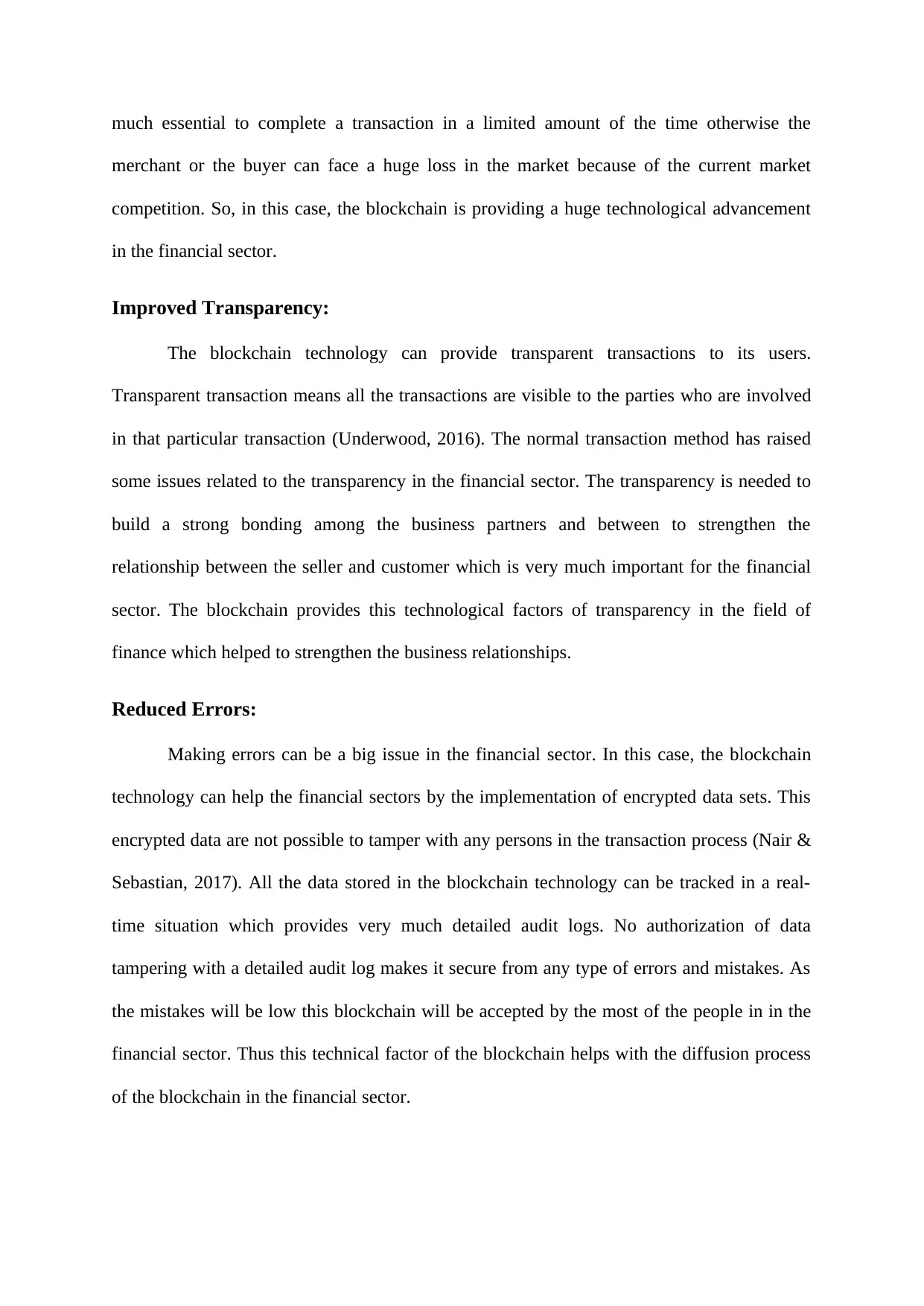
much essential to complete a transaction in a limited amount of the time otherwise the
merchant or the buyer can face a huge loss in the market because of the current market
competition. So, in this case, the blockchain is providing a huge technological advancement
in the financial sector.
Improved Transparency:
The blockchain technology can provide transparent transactions to its users.
Transparent transaction means all the transactions are visible to the parties who are involved
in that particular transaction (Underwood, 2016). The normal transaction method has raised
some issues related to the transparency in the financial sector. The transparency is needed to
build a strong bonding among the business partners and between to strengthen the
relationship between the seller and customer which is very much important for the financial
sector. The blockchain provides this technological factors of transparency in the field of
finance which helped to strengthen the business relationships.
Reduced Errors:
Making errors can be a big issue in the financial sector. In this case, the blockchain
technology can help the financial sectors by the implementation of encrypted data sets. This
encrypted data are not possible to tamper with any persons in the transaction process (Nair &
Sebastian, 2017). All the data stored in the blockchain technology can be tracked in a real-
time situation which provides very much detailed audit logs. No authorization of data
tampering with a detailed audit log makes it secure from any type of errors and mistakes. As
the mistakes will be low this blockchain will be accepted by the most of the people in in the
financial sector. Thus this technical factor of the blockchain helps with the diffusion process
of the blockchain in the financial sector.
merchant or the buyer can face a huge loss in the market because of the current market
competition. So, in this case, the blockchain is providing a huge technological advancement
in the financial sector.
Improved Transparency:
The blockchain technology can provide transparent transactions to its users.
Transparent transaction means all the transactions are visible to the parties who are involved
in that particular transaction (Underwood, 2016). The normal transaction method has raised
some issues related to the transparency in the financial sector. The transparency is needed to
build a strong bonding among the business partners and between to strengthen the
relationship between the seller and customer which is very much important for the financial
sector. The blockchain provides this technological factors of transparency in the field of
finance which helped to strengthen the business relationships.
Reduced Errors:
Making errors can be a big issue in the financial sector. In this case, the blockchain
technology can help the financial sectors by the implementation of encrypted data sets. This
encrypted data are not possible to tamper with any persons in the transaction process (Nair &
Sebastian, 2017). All the data stored in the blockchain technology can be tracked in a real-
time situation which provides very much detailed audit logs. No authorization of data
tampering with a detailed audit log makes it secure from any type of errors and mistakes. As
the mistakes will be low this blockchain will be accepted by the most of the people in in the
financial sector. Thus this technical factor of the blockchain helps with the diffusion process
of the blockchain in the financial sector.
⊘ This is a preview!⊘
Do you want full access?
Subscribe today to unlock all pages.

Trusted by 1+ million students worldwide
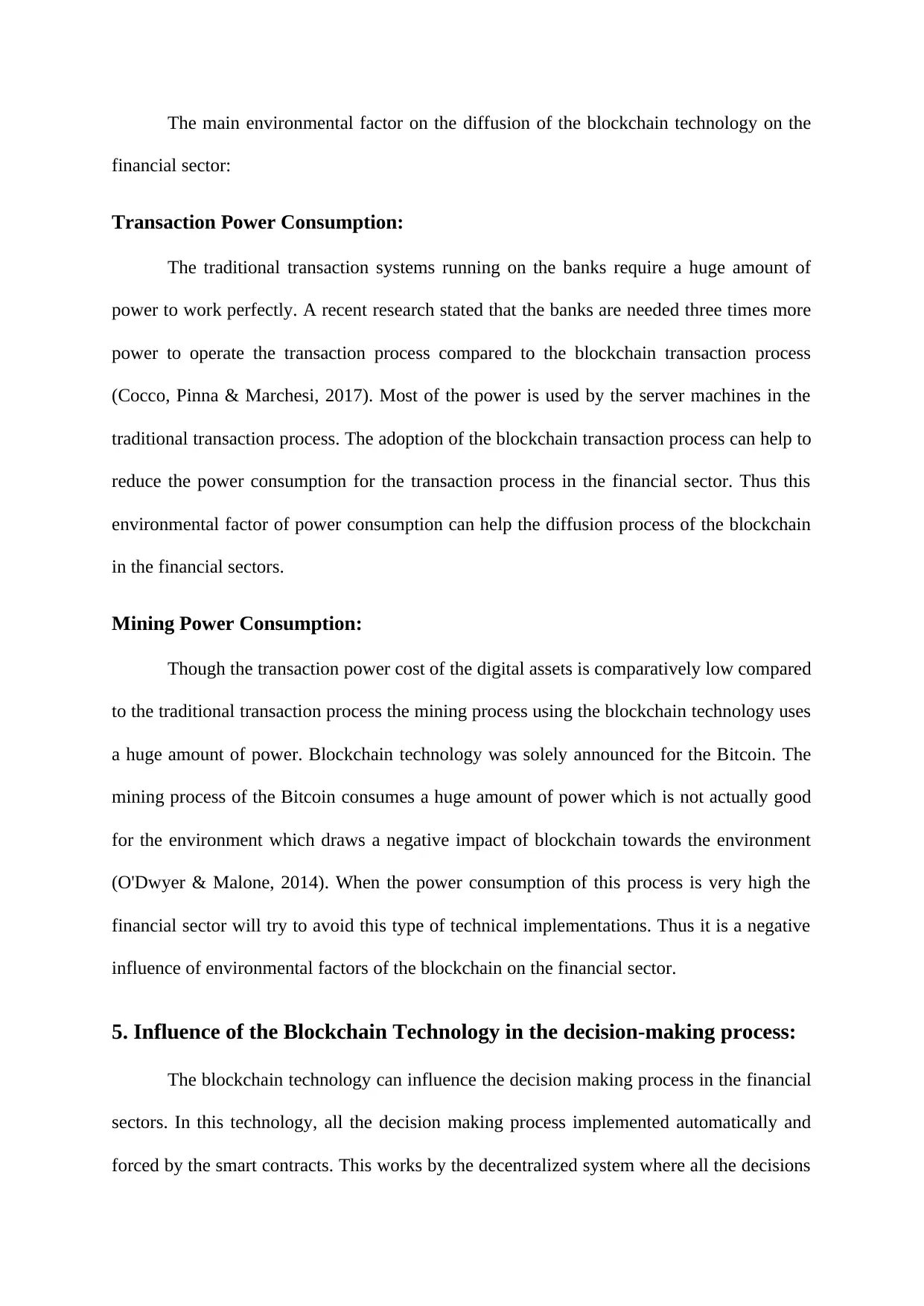
The main environmental factor on the diffusion of the blockchain technology on the
financial sector:
Transaction Power Consumption:
The traditional transaction systems running on the banks require a huge amount of
power to work perfectly. A recent research stated that the banks are needed three times more
power to operate the transaction process compared to the blockchain transaction process
(Cocco, Pinna & Marchesi, 2017). Most of the power is used by the server machines in the
traditional transaction process. The adoption of the blockchain transaction process can help to
reduce the power consumption for the transaction process in the financial sector. Thus this
environmental factor of power consumption can help the diffusion process of the blockchain
in the financial sectors.
Mining Power Consumption:
Though the transaction power cost of the digital assets is comparatively low compared
to the traditional transaction process the mining process using the blockchain technology uses
a huge amount of power. Blockchain technology was solely announced for the Bitcoin. The
mining process of the Bitcoin consumes a huge amount of power which is not actually good
for the environment which draws a negative impact of blockchain towards the environment
(O'Dwyer & Malone, 2014). When the power consumption of this process is very high the
financial sector will try to avoid this type of technical implementations. Thus it is a negative
influence of environmental factors of the blockchain on the financial sector.
5. Influence of the Blockchain Technology in the decision-making process:
The blockchain technology can influence the decision making process in the financial
sectors. In this technology, all the decision making process implemented automatically and
forced by the smart contracts. This works by the decentralized system where all the decisions
financial sector:
Transaction Power Consumption:
The traditional transaction systems running on the banks require a huge amount of
power to work perfectly. A recent research stated that the banks are needed three times more
power to operate the transaction process compared to the blockchain transaction process
(Cocco, Pinna & Marchesi, 2017). Most of the power is used by the server machines in the
traditional transaction process. The adoption of the blockchain transaction process can help to
reduce the power consumption for the transaction process in the financial sector. Thus this
environmental factor of power consumption can help the diffusion process of the blockchain
in the financial sectors.
Mining Power Consumption:
Though the transaction power cost of the digital assets is comparatively low compared
to the traditional transaction process the mining process using the blockchain technology uses
a huge amount of power. Blockchain technology was solely announced for the Bitcoin. The
mining process of the Bitcoin consumes a huge amount of power which is not actually good
for the environment which draws a negative impact of blockchain towards the environment
(O'Dwyer & Malone, 2014). When the power consumption of this process is very high the
financial sector will try to avoid this type of technical implementations. Thus it is a negative
influence of environmental factors of the blockchain on the financial sector.
5. Influence of the Blockchain Technology in the decision-making process:
The blockchain technology can influence the decision making process in the financial
sectors. In this technology, all the decision making process implemented automatically and
forced by the smart contracts. This works by the decentralized system where all the decisions
Paraphrase This Document
Need a fresh take? Get an instant paraphrase of this document with our AI Paraphraser
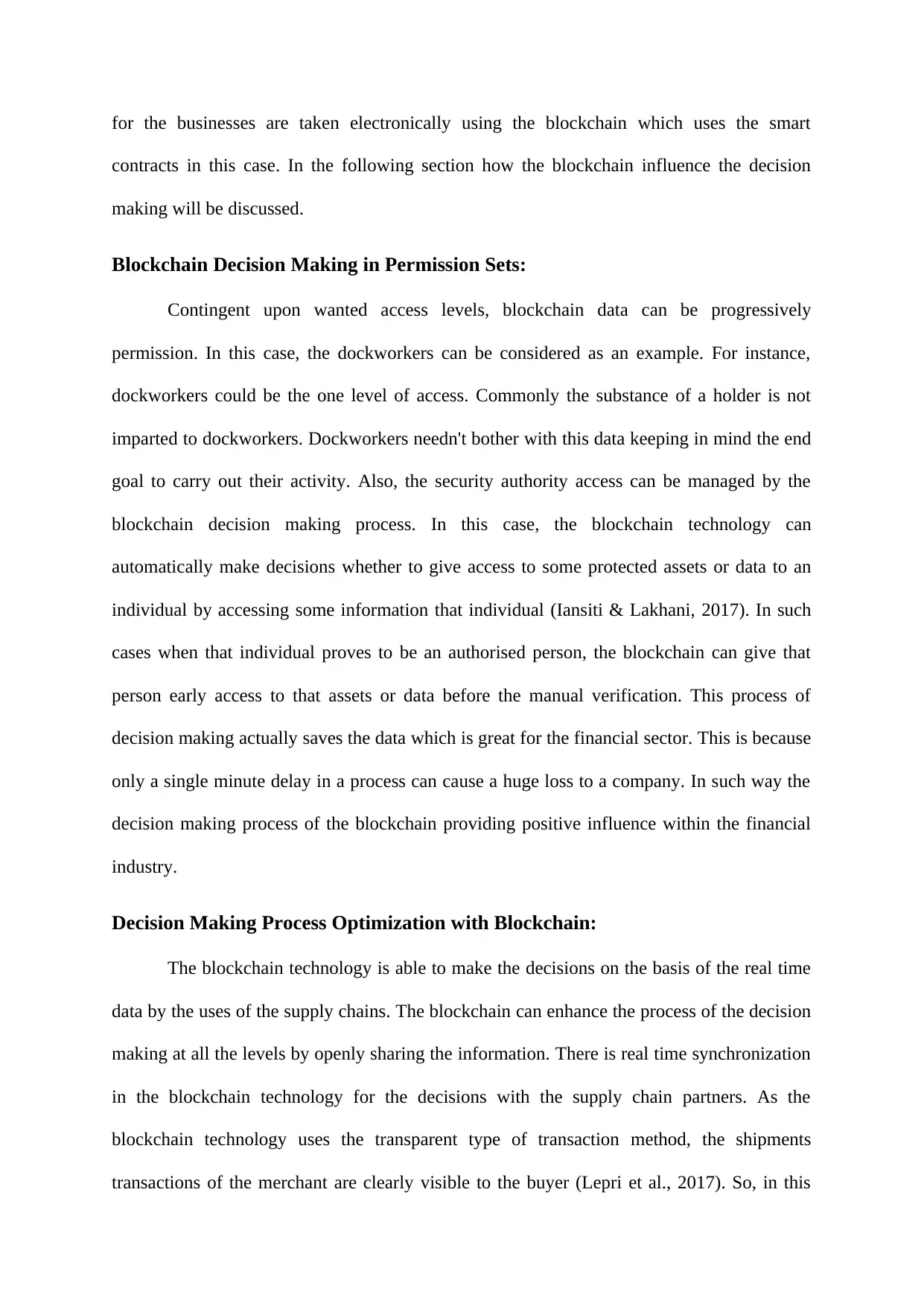
for the businesses are taken electronically using the blockchain which uses the smart
contracts in this case. In the following section how the blockchain influence the decision
making will be discussed.
Blockchain Decision Making in Permission Sets:
Contingent upon wanted access levels, blockchain data can be progressively
permission. In this case, the dockworkers can be considered as an example. For instance,
dockworkers could be the one level of access. Commonly the substance of a holder is not
imparted to dockworkers. Dockworkers needn't bother with this data keeping in mind the end
goal to carry out their activity. Also, the security authority access can be managed by the
blockchain decision making process. In this case, the blockchain technology can
automatically make decisions whether to give access to some protected assets or data to an
individual by accessing some information that individual (Iansiti & Lakhani, 2017). In such
cases when that individual proves to be an authorised person, the blockchain can give that
person early access to that assets or data before the manual verification. This process of
decision making actually saves the data which is great for the financial sector. This is because
only a single minute delay in a process can cause a huge loss to a company. In such way the
decision making process of the blockchain providing positive influence within the financial
industry.
Decision Making Process Optimization with Blockchain:
The blockchain technology is able to make the decisions on the basis of the real time
data by the uses of the supply chains. The blockchain can enhance the process of the decision
making at all the levels by openly sharing the information. There is real time synchronization
in the blockchain technology for the decisions with the supply chain partners. As the
blockchain technology uses the transparent type of transaction method, the shipments
transactions of the merchant are clearly visible to the buyer (Lepri et al., 2017). So, in this
contracts in this case. In the following section how the blockchain influence the decision
making will be discussed.
Blockchain Decision Making in Permission Sets:
Contingent upon wanted access levels, blockchain data can be progressively
permission. In this case, the dockworkers can be considered as an example. For instance,
dockworkers could be the one level of access. Commonly the substance of a holder is not
imparted to dockworkers. Dockworkers needn't bother with this data keeping in mind the end
goal to carry out their activity. Also, the security authority access can be managed by the
blockchain decision making process. In this case, the blockchain technology can
automatically make decisions whether to give access to some protected assets or data to an
individual by accessing some information that individual (Iansiti & Lakhani, 2017). In such
cases when that individual proves to be an authorised person, the blockchain can give that
person early access to that assets or data before the manual verification. This process of
decision making actually saves the data which is great for the financial sector. This is because
only a single minute delay in a process can cause a huge loss to a company. In such way the
decision making process of the blockchain providing positive influence within the financial
industry.
Decision Making Process Optimization with Blockchain:
The blockchain technology is able to make the decisions on the basis of the real time
data by the uses of the supply chains. The blockchain can enhance the process of the decision
making at all the levels by openly sharing the information. There is real time synchronization
in the blockchain technology for the decisions with the supply chain partners. As the
blockchain technology uses the transparent type of transaction method, the shipments
transactions of the merchant are clearly visible to the buyer (Lepri et al., 2017). So, in this
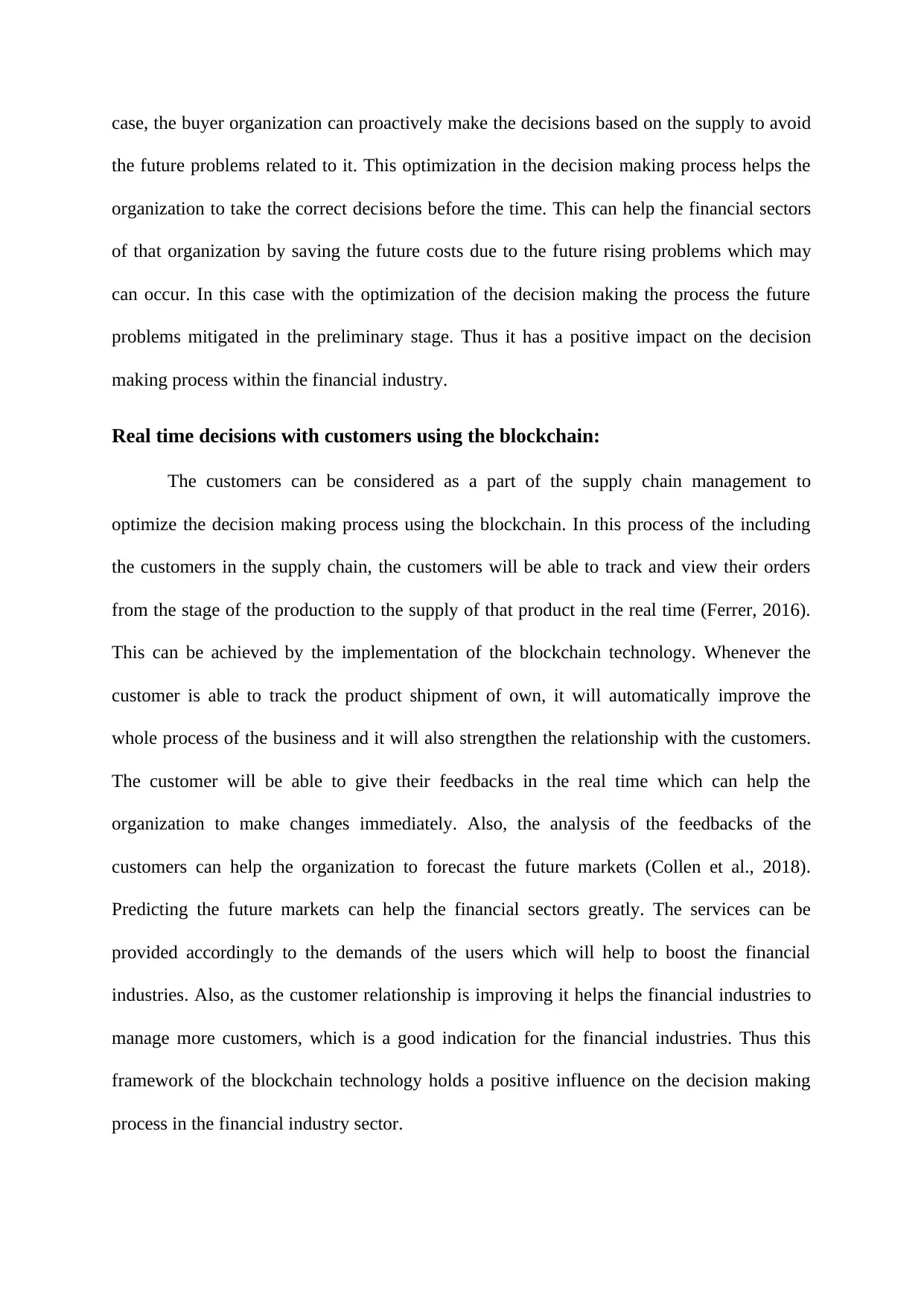
case, the buyer organization can proactively make the decisions based on the supply to avoid
the future problems related to it. This optimization in the decision making process helps the
organization to take the correct decisions before the time. This can help the financial sectors
of that organization by saving the future costs due to the future rising problems which may
can occur. In this case with the optimization of the decision making the process the future
problems mitigated in the preliminary stage. Thus it has a positive impact on the decision
making process within the financial industry.
Real time decisions with customers using the blockchain:
The customers can be considered as a part of the supply chain management to
optimize the decision making process using the blockchain. In this process of the including
the customers in the supply chain, the customers will be able to track and view their orders
from the stage of the production to the supply of that product in the real time (Ferrer, 2016).
This can be achieved by the implementation of the blockchain technology. Whenever the
customer is able to track the product shipment of own, it will automatically improve the
whole process of the business and it will also strengthen the relationship with the customers.
The customer will be able to give their feedbacks in the real time which can help the
organization to make changes immediately. Also, the analysis of the feedbacks of the
customers can help the organization to forecast the future markets (Collen et al., 2018).
Predicting the future markets can help the financial sectors greatly. The services can be
provided accordingly to the demands of the users which will help to boost the financial
industries. Also, as the customer relationship is improving it helps the financial industries to
manage more customers, which is a good indication for the financial industries. Thus this
framework of the blockchain technology holds a positive influence on the decision making
process in the financial industry sector.
the future problems related to it. This optimization in the decision making process helps the
organization to take the correct decisions before the time. This can help the financial sectors
of that organization by saving the future costs due to the future rising problems which may
can occur. In this case with the optimization of the decision making the process the future
problems mitigated in the preliminary stage. Thus it has a positive impact on the decision
making process within the financial industry.
Real time decisions with customers using the blockchain:
The customers can be considered as a part of the supply chain management to
optimize the decision making process using the blockchain. In this process of the including
the customers in the supply chain, the customers will be able to track and view their orders
from the stage of the production to the supply of that product in the real time (Ferrer, 2016).
This can be achieved by the implementation of the blockchain technology. Whenever the
customer is able to track the product shipment of own, it will automatically improve the
whole process of the business and it will also strengthen the relationship with the customers.
The customer will be able to give their feedbacks in the real time which can help the
organization to make changes immediately. Also, the analysis of the feedbacks of the
customers can help the organization to forecast the future markets (Collen et al., 2018).
Predicting the future markets can help the financial sectors greatly. The services can be
provided accordingly to the demands of the users which will help to boost the financial
industries. Also, as the customer relationship is improving it helps the financial industries to
manage more customers, which is a good indication for the financial industries. Thus this
framework of the blockchain technology holds a positive influence on the decision making
process in the financial industry sector.
⊘ This is a preview!⊘
Do you want full access?
Subscribe today to unlock all pages.

Trusted by 1+ million students worldwide
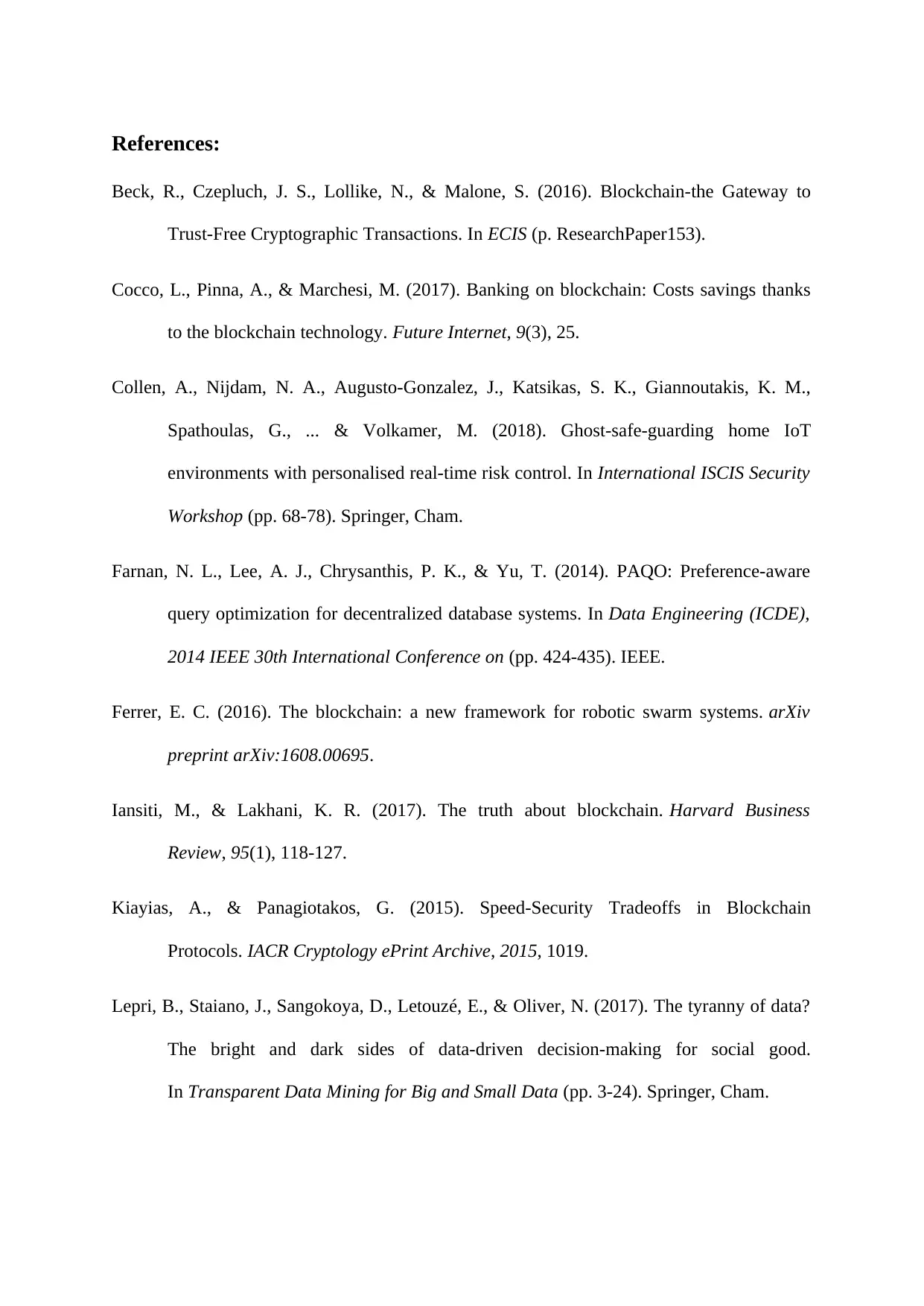
References:
Beck, R., Czepluch, J. S., Lollike, N., & Malone, S. (2016). Blockchain-the Gateway to
Trust-Free Cryptographic Transactions. In ECIS (p. ResearchPaper153).
Cocco, L., Pinna, A., & Marchesi, M. (2017). Banking on blockchain: Costs savings thanks
to the blockchain technology. Future Internet, 9(3), 25.
Collen, A., Nijdam, N. A., Augusto-Gonzalez, J., Katsikas, S. K., Giannoutakis, K. M.,
Spathoulas, G., ... & Volkamer, M. (2018). Ghost-safe-guarding home IoT
environments with personalised real-time risk control. In International ISCIS Security
Workshop (pp. 68-78). Springer, Cham.
Farnan, N. L., Lee, A. J., Chrysanthis, P. K., & Yu, T. (2014). PAQO: Preference-aware
query optimization for decentralized database systems. In Data Engineering (ICDE),
2014 IEEE 30th International Conference on (pp. 424-435). IEEE.
Ferrer, E. C. (2016). The blockchain: a new framework for robotic swarm systems. arXiv
preprint arXiv:1608.00695.
Iansiti, M., & Lakhani, K. R. (2017). The truth about blockchain. Harvard Business
Review, 95(1), 118-127.
Kiayias, A., & Panagiotakos, G. (2015). Speed-Security Tradeoffs in Blockchain
Protocols. IACR Cryptology ePrint Archive, 2015, 1019.
Lepri, B., Staiano, J., Sangokoya, D., Letouzé, E., & Oliver, N. (2017). The tyranny of data?
The bright and dark sides of data-driven decision-making for social good.
In Transparent Data Mining for Big and Small Data (pp. 3-24). Springer, Cham.
Beck, R., Czepluch, J. S., Lollike, N., & Malone, S. (2016). Blockchain-the Gateway to
Trust-Free Cryptographic Transactions. In ECIS (p. ResearchPaper153).
Cocco, L., Pinna, A., & Marchesi, M. (2017). Banking on blockchain: Costs savings thanks
to the blockchain technology. Future Internet, 9(3), 25.
Collen, A., Nijdam, N. A., Augusto-Gonzalez, J., Katsikas, S. K., Giannoutakis, K. M.,
Spathoulas, G., ... & Volkamer, M. (2018). Ghost-safe-guarding home IoT
environments with personalised real-time risk control. In International ISCIS Security
Workshop (pp. 68-78). Springer, Cham.
Farnan, N. L., Lee, A. J., Chrysanthis, P. K., & Yu, T. (2014). PAQO: Preference-aware
query optimization for decentralized database systems. In Data Engineering (ICDE),
2014 IEEE 30th International Conference on (pp. 424-435). IEEE.
Ferrer, E. C. (2016). The blockchain: a new framework for robotic swarm systems. arXiv
preprint arXiv:1608.00695.
Iansiti, M., & Lakhani, K. R. (2017). The truth about blockchain. Harvard Business
Review, 95(1), 118-127.
Kiayias, A., & Panagiotakos, G. (2015). Speed-Security Tradeoffs in Blockchain
Protocols. IACR Cryptology ePrint Archive, 2015, 1019.
Lepri, B., Staiano, J., Sangokoya, D., Letouzé, E., & Oliver, N. (2017). The tyranny of data?
The bright and dark sides of data-driven decision-making for social good.
In Transparent Data Mining for Big and Small Data (pp. 3-24). Springer, Cham.
Paraphrase This Document
Need a fresh take? Get an instant paraphrase of this document with our AI Paraphraser

Nair, G. R., & Sebastian, S. (2017). BlockChain Technology Centralised Ledger to
Distributed Ledger.
O'Dwyer, K. J., & Malone, D. (2014). Bitcoin mining and its energy footprint.
Swan, M. (2015). Blockchain: Blueprint for a new economy. " O'Reilly Media, Inc.".
Underwood, S. (2016). Blockchain beyond bitcoin. Communications of the ACM, 59(11), 15-
17.
Distributed Ledger.
O'Dwyer, K. J., & Malone, D. (2014). Bitcoin mining and its energy footprint.
Swan, M. (2015). Blockchain: Blueprint for a new economy. " O'Reilly Media, Inc.".
Underwood, S. (2016). Blockchain beyond bitcoin. Communications of the ACM, 59(11), 15-
17.
1 out of 8
Related Documents
Your All-in-One AI-Powered Toolkit for Academic Success.
+13062052269
info@desklib.com
Available 24*7 on WhatsApp / Email
![[object Object]](/_next/static/media/star-bottom.7253800d.svg)
Unlock your academic potential
Copyright © 2020–2025 A2Z Services. All Rights Reserved. Developed and managed by ZUCOL.





